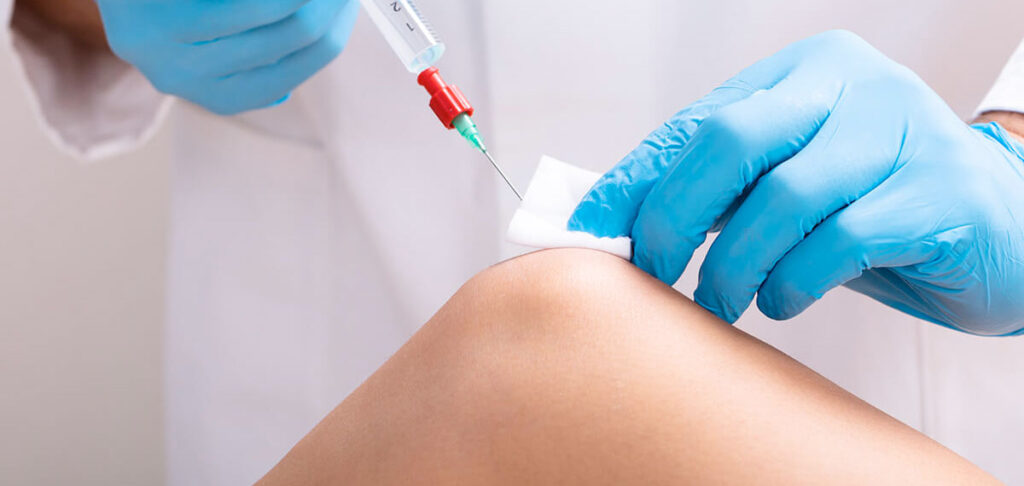Joint injection is a procedure in the field of medicine that involves directly injecting any joint in the human body for the purpose of relieving stiffness, inflammation, and pain. Before concerning oneself with the basics of joint injection techniques, London Aesthetics UK finds the following as important to consider:
– The patient’s local and referred pain histories, as this will provide the underlying pathology’s important clues.
– A physical examination, as an ascertained diagnosis can be ensured with its help.
– The injection area’s anatomical knowledge, which is essential.
– The avoidance of intratendinous injection, as it increases the likelihood of the tendon falling weak.
– The avoidance of corticosteroid injection, except for in cases of patella and Achilles tendinopathies.
Taking into account the above considerations, London Aesthetics UK then moves onward to the basics of joint injection techniques, which include several techniques different in nature such as:
Joint Aspiration:
One of the basics of joint injection techniques provided by London Aesthetics UK is joint aspiration, which is the procedure that involves fluid removal from the space encompassing a joint, most often from the knee joint but also from the wrist, elbow, shoulder, ankle, and hip joints, by the use of a syringe/needle. It is usually done to diagnose and assist in joint problems and disorders, such as the conditions of joint infection, varying arthritis types, and gout by means of fluid analysis. The fluid removal can improve joint movement, relieve pain and pressure.
Intra-articular Injection:
Next up in the the basics of joint injection techniques at London Aesthetics UK is intra-articular injection, when the joint is directly injected to relieve pain. The substances most commonly injected for this joint treatment are:
Corticosteroids:
These inhibit inflammatory cell production that are produced naturally to respond to chronic or acute injury conditions, thereby decreasing local inflammation. The most common usage of intra-articular treatments in the basics of joint injection techniques is to treat knee rheumatoid arthritis, acute gout and osteoarthritis. They are administered typically at a minimum gap of three months apart. The steroid type used determines the relief duration of the process.
Hyaluronic Acid:
Another one of the the basics of joint injection techniques in intra-articular injection types is hyaluronic acid that is naturally found in synovial fluids that lead to joint lubrication. Osteoarthritis can break down this substance, thereby worsening the disorder. The usage of intra-articular injections is to improve a joint’s motion range, reduce pain and increase lubrication. They are administered typically as a shot series over a schedule of three to five weeks. For people who can’t tolerate steroids and can’t find oral medication relieving, these injections are mainly preferred in order to buy time before surgically replacing the knee.
Local Anesthetics:
Intra-articular injections in the basics of joint injection techniques sometimes deliver these to relieve pain after anthroscopic surgery.
Botulinum Toxin:
This is the most heard of in the basics of joint injection techniques in intra-articular injection types; botox injections can effectively and safely relieve painful osteoarthritis of the knee. The treatment’s effects can last ranging from four weeks to twelve weeks.
Platelet-Rich Plasma:
The last of the types of intra-articular injections in the basics of joint injection techniques is PRP, which contains plasma and platelets, and can improve joint function and aid in pain reduction. The benefits of the treatment can last between six to nine months.
The third in the list of the basics of joint injection techniques provided by London Aesthetics UK is TPI; trigger points are painful muscle knots that are pressure-sensitive. They can form after repetitive micro-trauma or acute trauma, resulting in muscle fiber stress. A TPI is a medicine injection that injects into a trigger point to soothe lower back (quadratus lumborum), legs, arms, shoulder (trapezius) and neck (sternocleidomastoid, levator scapulae) myofascial pain. They commonly involve local anesthetic injections without or with botulinum toxin, corticosteroid, or simply by dry needling. We consider a TPI if other treatments such as physical therapy, myofascial release, massage therapy, heat therapy and medication do not improve pain due to a trigger point. We use a TPI alongside stretching exercises and physical therapy for not only pain alleviation but also for physical therapy effectiveness.
Soft Tissue Injection:
Next up in the list of the basics of joint injection techniques is soft tissue injection. It is provided by London Aesthetics UK. We inject this in the soft tissue area encompassing a joint. Such areas include a bursa, muscle or tendon. These injections treat problems such as bursitis and tendinitis. This injection injects more than one medicine. An example is when local anesthetics provide long-term relief by steroid medicines and short-term relief in pain. Steroids either relieve pain a few days after injection which can last ranging from days to months or not at all.
Periarticular Injection:
Finally in the basics of joint injection techniques provided by London Aesthetics UK is a regional analgesia technique. In this technique, we inject the medicine in the joint area and not in the joint itself. We perform it to relieve pain and consume less opioid amounts after a total hip arthroplasty (THA) surgery. We consider it a safe pain management option in THA surgery.

